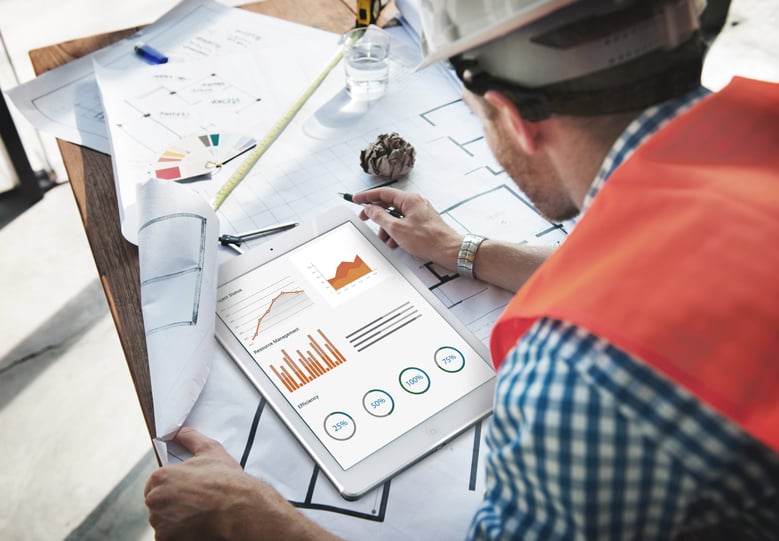The world is in the midst of technological change - from advancements that were already happening to those that are starting to emerge in response to increased customer demands. What does that mean for the equipment leasing sector? And how can you adjust your business model to ensure it thrives in this unpredictable environment?
Here are some of the top technology trends that are having an impact in the equipment leasing space:
- Predictive analytics
- Artificial intelligence and machine learning
- Virtual and augmented reality
- 3D printing
- Alternative power
- Remote operation
- Blockchain
1. Predictive analytics

Use IoT-generated data to improve process efficiency, visibility and profit margins. If you’re only using IoT to fix issues when they happen (in other words, the break-fix approach), you’re not getting the most out of your equipment.
In addition to receiving updates (error and performance messages etc) on your IoT-enabled devices, why not integrate with data analytics/business intelligence tools? These tools could help you perform root cause analysis so you can avoid experiencing the same issues repeatedly.
They can also help you better predict when equipment maintenance is due. Usually, equipment rental companies will follow the original equipment manufacturer’s (OEM) maintenance schedules.
However, IoT-enabled devices combined with data analytics software can help you predict this schedule. Now you can ensure your assets are maintained at the right time, increasing their performance, efficiency and utilisation rate.
2. Artificial intelligence and machine learning
Today’s equipment rental machinery typically feature sensors that monitor its geographic location, consumption/usage, performance and maintenance schedules (as mentioned above). Some may even automatically start a service call if the machine isn’t working as it should.
Machine learning and AI will take this data, analyse it and continuously improve the asset. And it’s all automated so there’s minimal manual work needed. Not only will this save your employees time but it can improve data accuracy and give you access to in-depth insights into your assets.
The short story? You can make more informed business decisions, improve machinery performance and boost customer satisfaction.
3. Virtual and augmented reality
 Photo by Andrea Piacquadio
Photo by Andrea Piacquadio
Create and deliver more immersive customer experiences to improve their overall satisfaction and perception of your company. For example, virtual and augmented reality can help your customers:
- Choose the right equipment for their needs as they can see exactly what they could be renting
- Use equipment as per best practices
- Troubleshoot commonly occurring (minor) issues (e.g. your maintenance team can connect with customers and remotely diagnose and fix issues)
Here are some benefits of the above:
- Extend the lifetime of your asset
- Ensure safety
- Give time back to your employees as they’re less likely to need to help these users. Now they have more time to focus on users and issues who really need their attention
- Give your maintenance team exactly what they need to repair equipment which will improve first-time-fix-rate
4. 3D printing
If equipment breaks down, it may not only be costly to replace a part - there may also be a long lead time which can obviously lead to that asset being sidelined until it can be fixed. You might have business intelligence tools and IoT-enabled devices to help you better predict breakdowns, ensure maintenance schedules are up-to-date and that you have the right number of spare parts in stock.
However, breakages can still happen. There may be no prior signs and you might experience that one occasion where the precise spare part you need has just gone out of stock!
3D printing technology can help mitigate this. Imagine if you could print spare parts on demand. Not only does that widen the possibilities but it also frees up your warehouse space. You could also add certain 3D-printed products to your catalogue - which creates a new revenue stream.
Not every part or material can be printed at the moment but this could change in the future.
5. Alternative power
Like the lithium (li-ion) battery which has transformed the portable power tool market, alternative battery systems are being developed to power larger pieces of machinery. This could see benefits, such as:
- The ability to use the equipment anywhere
- Reduced exhaust production
6. Remote operation

While we’re on the topic of portable tools, the need for remote operations is growing. For example, 5G-enabled/wireless devices (e.g. a handheld tablet or mobile phone) that are integrated with your ERP and CRM systems can help your field-based teams work more productively while on-the-go.
They can:
- Access the right data at the right time…
- …which can enable them to complete their tasks more quickly and efficiently…
- …which boosts first-time-fix-rate
- Transfer data in real-time…
- …which facilitates cross-team/departmental collaboration
7. Blockchain
Blockchain is a relatively new piece of technology that holds enormous potential. While it’s more commonly used in the financial world, it can also transform the way data is stored, managed and shared.
Let’s put it into context for the equipment rental sector. Data is commonly siloed because it’s stored in different systems and formats (sometimes these formats aren’t even compatible with each other which opens a whole new can of worms, but let’s not get started on that!).
Blockchain technology can centralise all this information. Purchase price, purchase date, equipment specifications, customer contracts, maintenance schedules - all of this can be consolidated into one location so it’s much easier to gain a clear, real-time view of the equipment lifecycle.
It’s time to revitalise your equipment rental business. Know where to start?
The above technology examples are just a summary of the top trends impacting the rental sector. But it’s not enough to simply choose and implement modern technology into your business. Though it may help, you also need to consider how that tech would fit into your existing processes, whether it would help your team, your customers and so on.
In our guide, we dive deeper into how you can innovate your equipment rental business. Ready to refresh and revitalise your organisation? Download it below.

